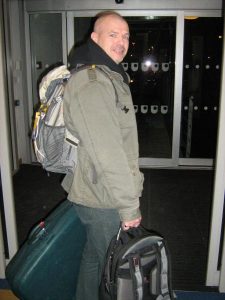News Story
KMi iPhone apps and ERA go to Nicaragua
Wednesday 3 Feb 2010
Paul Hogan from KMi will be heading off on Saturday for two weeks of fieldwork on a volcano in Nicaragua. Paul has developed several iPhone applications (as part of the iTunes U project) for use by the geophysicists and environmental scientists whilst on the volcano and he is going out to experience their use first hand. He will also be investigating remote access to field sites as part of ERA’s Portable WLAN backhaul trials.
iPhone apps
Recently Paul’s work on the iPhone has been looking at developing location based applications that make use of the iPhone’s location services and build on the OpenGIS KML geographic data schema.
One app uses Google maps to help field scientists locate points of interest in a field site (a bit like a SatNav system). It then provides a data entry form for recording data that is automatically date-stamped and geo-tagged. Each day’s collected data can be downloaded from the iPhone as an easy to access database file.
The second app Paul will be developing provides similar functionality, but uses an augmented reality representation rather than a map. Again we’re building on the standard KML data scheme, but this time instead of showing points in a map the points overlayed on the iPhone’s camera view. As the camera is pointed at an item of interest, the item on screen is literally annotated with a label saying what it is, how far away it is and offering a link to further information.
ERA – Portable WLAN Backhaul Trial
Paul’s second application is tied to the Enabling Remote Activity project where, as part of JANET’s Portable WLAN Programme, we are looking at ways to access remote fieldwork locations via the internet. Paul will be trying an ADSL broadband link, a 3G mobile broadband dongle, and a BGAN satellite terminal, to establish a ‘back-haul’ connection from Nicaragua to the OU.
The goal here is not simply to get a connection to access the internet, but to set up a mobile servers that anyone in a remote field site can use to send data, photos, live video broadcasts and two-way audio to anyone on the web. Investigating the three different connection methods will help us identify the types of services supported by each one and the resources involved to set them up.
To see how Paul’s getting, on have a look at the Portable WLAN blog (link listed below), where Paul and the rest of the ERA team will be posting their findings during the trials.
Related Links:
- The Open University on iTunes U
- KMi Mobile Applications
- Enabling Remote Activity (ERA) Project website
- JANETs Portable WLAN Programme website
- ERA Portable WLAN wiki pages
- ERA Portable WLAN Blog
- EarthWatch Volcano Expedition
- OU Department of Earth and Environmental Sciences
- open2.net Science, Technology and Nature Blog
Latest News
PhD Awarded for Groundbreaking Research on Game-Based Cyber Security Training
KMi at the Palace of Westminster: Exploring Blockchain for Society and Economy
OUAnalyse at the Digital Ethics Summit 2025: Advancing Responsible AI in Education

